Les ventes d’instruments du quatuor sont principalement composées de modèles de grands maîtres du passé – généralement morts depuis des siècles – pouvant nous laisser croire que cet art s’est perdu avec eux. Pourtant, il existe une lutherie contemporaine de très haute qualité à l’origine d’instruments admirables, recherchés par les plus grands virtuoses de notre temps. C’est le cas du modèle que nous allons vous présenter aujourd’hui et qui sera vendu le 2 décembre 2021 – le Faust -, un violon réalisé par Stephan von Baehr ayant appartenu à Isabelle Faust…
Stephan von Baehr fait partie de ces personnes dont la passion est communicative. Animé par l’amour du violon et le respect des maîtres anciens, ses instruments mêlent savoir-faire traditionnel et écoute des musiciens. Comme il l’explique, sa passion lui vient sans doute de ses parents, tous deux premiers violons solos, et a certainement été exacerbée à la chute du mur de Berlin. Ayant grandi en Allemagne de l’Est, tout un univers s’ouvre à lui en 1989, lui offrant l’opportunité de partir à la découverte des instruments de grands maîtres tant rêvés… Après un apprentissage dans l’atelier de Reinhard Bönsch à Markneukirchen où il s’est également formé à la sculpture auprès de Jochen Heinzmann vers 1990, il rejoint Andreas Kägi à Berlin et étudie scrupuleusement plusieurs instruments de Stradivari.
À partir de 1993, il est employé chez Sabatier à Paris et se perfectionne dans la restauration et l’expertise d’instruments anciens. Depuis, Stephan von Baehr n’a pas arrêté de voyager, partage sa vie entre Hambourg et Paris et est également très présent dans les pays anglophones et asiatiques. Aujourd’hui, il est l’un des luthiers vivants les plus réputés et sollicités du monde. Une passion si communicative que sa fille, Léonie von Baehr, est devenue luthière il y a deux ans et l’a depuis rejoint dans l’atelier. La filiation semble donc parfaitement assurée…
En 30 ans de carrière, Stephan von Baehr s’est créé une réputation qui n’est plus à démontrer. Diplômé Maître luthier en 1995, son travail connaît rapidement le succès, en partie grâce au RNCM International Cello de 1998 à Manchester, au cours duquel l’une de ses créations est célébrée par le jury alors présidé par Charles Beare. Cet événement est décisif puisqu’il motive Stephan von Baehr à établir son propre atelier rue de Rome à Paris, afin de fabriquer ses propres instruments. Un an plus tard, il remporte les médailles d’or et de bronze au concours international de lutherie de la ville de Paris, créé par Étienne Vatelot, célèbre luthier dont le cabinet d’expertises travaille avec Vichy Enchères
Depuis, Stephan est resté très attaché à la Maison Vatelot et à ses successeurs Jean-Jacques Rampal et Jonathan Marolle. Ainsi, la carrière de Stephan von Baehr est jalonnée de succès rencontrés dans le monde, que ce soit en Europe, Asie et aux Etats-Unis, où il décroche plusieurs prix pour ses instruments du quatuor – ultime consécration pour un luthier. Il obtient tout d’abord une médaille d’argent en 2004, au concours international de lutherie de Portland, ainsi que trois prix spéciaux pour chacun de ses instruments du quatuor (violon, alto, violoncelle). Suivis, en 2012, d’une médaille d’or pour son quatuor présenté au concours international de lutherie de Cleveland.
La qualité de ses instruments est également attestée par leur présence dans les plus grands orchestres. Cela signifie aussi qu’ils sont joués par les musiciens les plus talentueux de notre époque. Ce phénomène est particulièrement intéressant car il aurait été quasiment inconcevable, vingt ans auparavant, qu’un violon solo joue sur un instrument neuf. On constate donc un changement de mentalité qui s’explique entre autres par le travail de luthiers comme Stephan von Baehr.
Rainer Honeck, concertmaster de l’orchestre philharmonique de Vienne, nous en offre un exemple significatif puisqu’il s’affichait dans le Strad de février 2013 avec son Stradivari de 1709 et sa copie réalisée par Stephan. Le violoncelliste solo du Berliner Philharmoniker, Olaf Maninger, n’a pas non plus hésité à présenter sa copie de Domenico Montagnana à la presse. Enfin, Xiaoming Wang – primarius du Quatuor Stradivarius de Suisse et violon solo de l’orchestre de Zurich – joue maintenant sur une copie de l’Aurea de Stradivari (1715), un instrument qui l’a accompagné dix-sept ans.
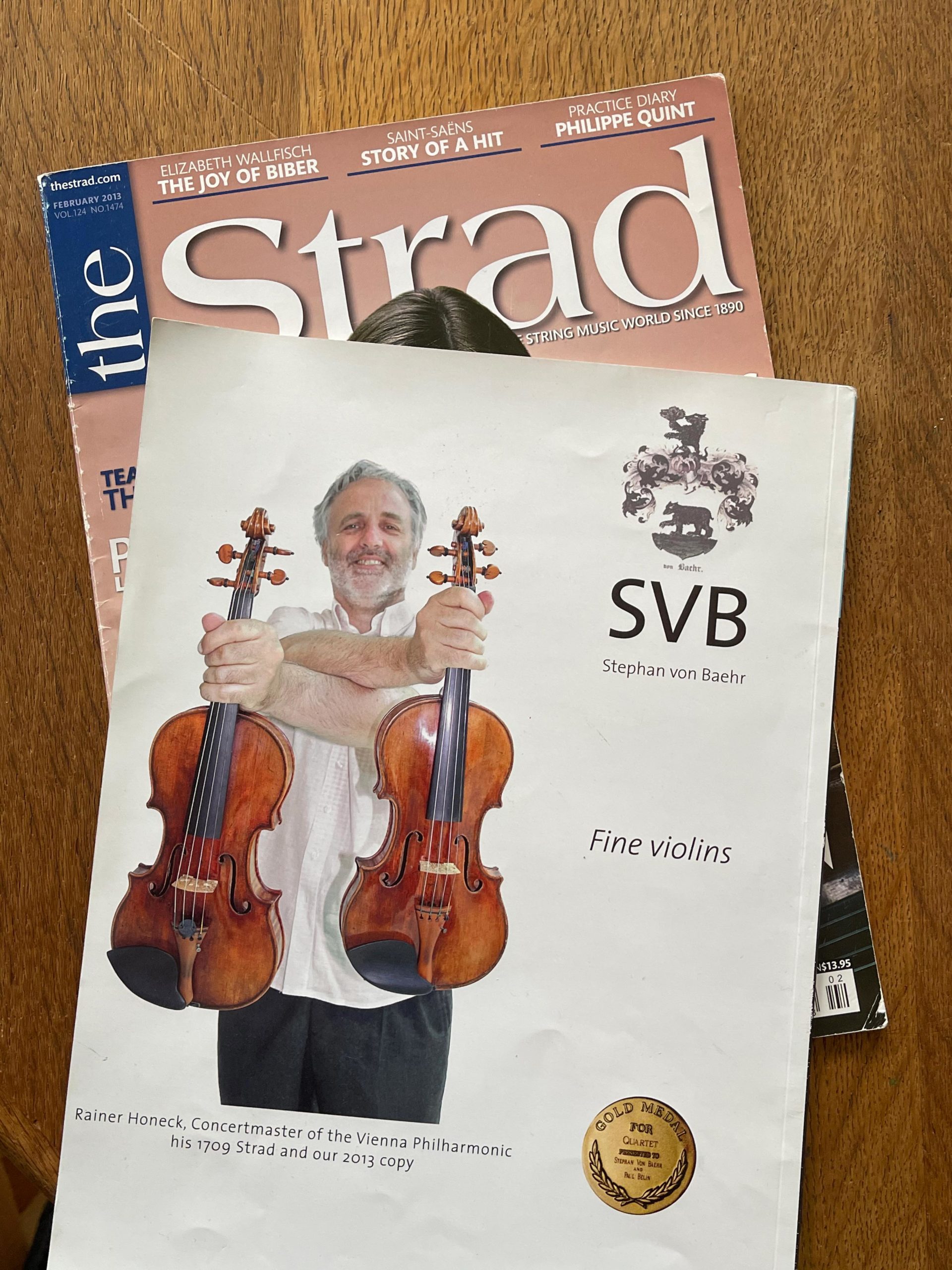
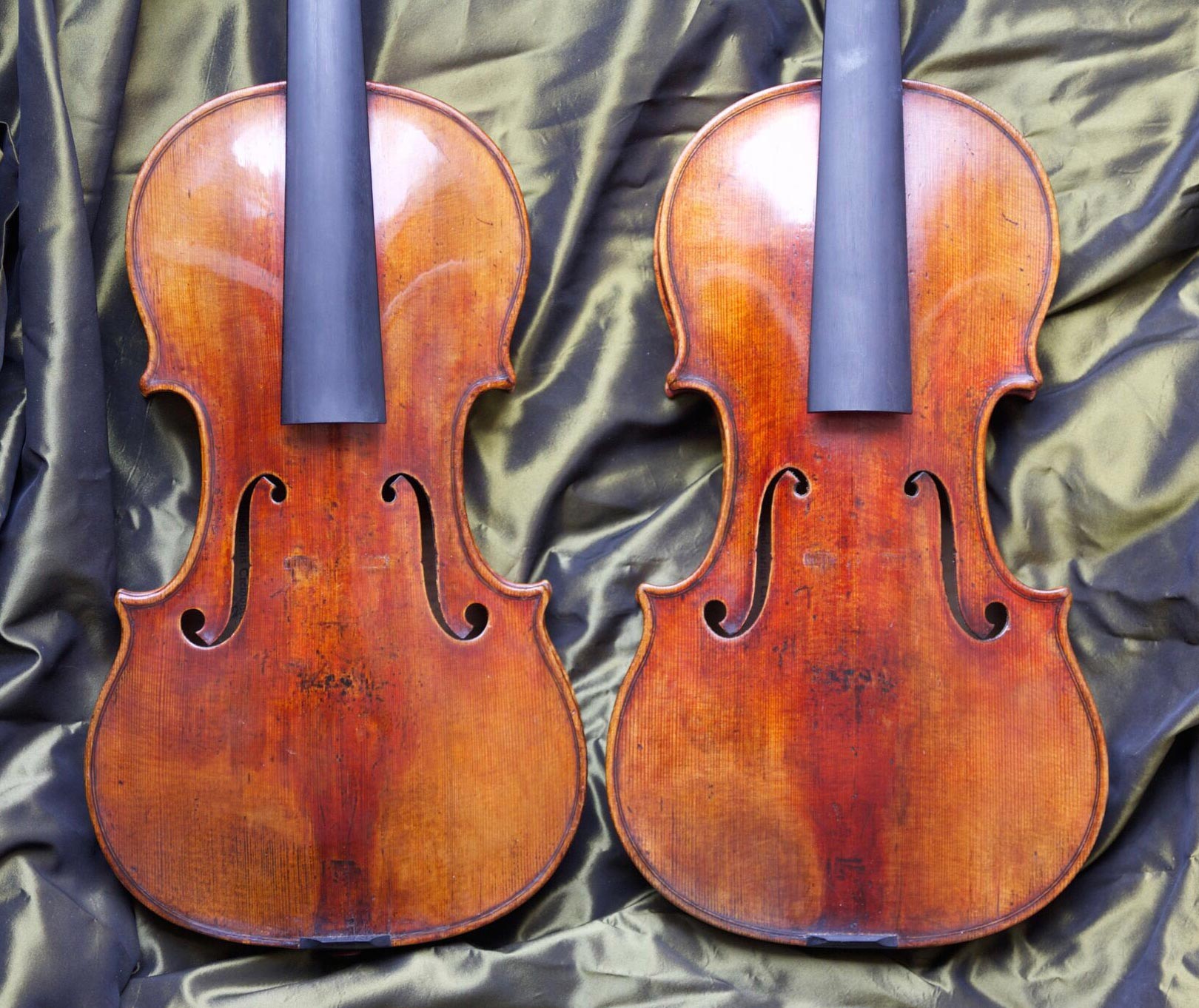
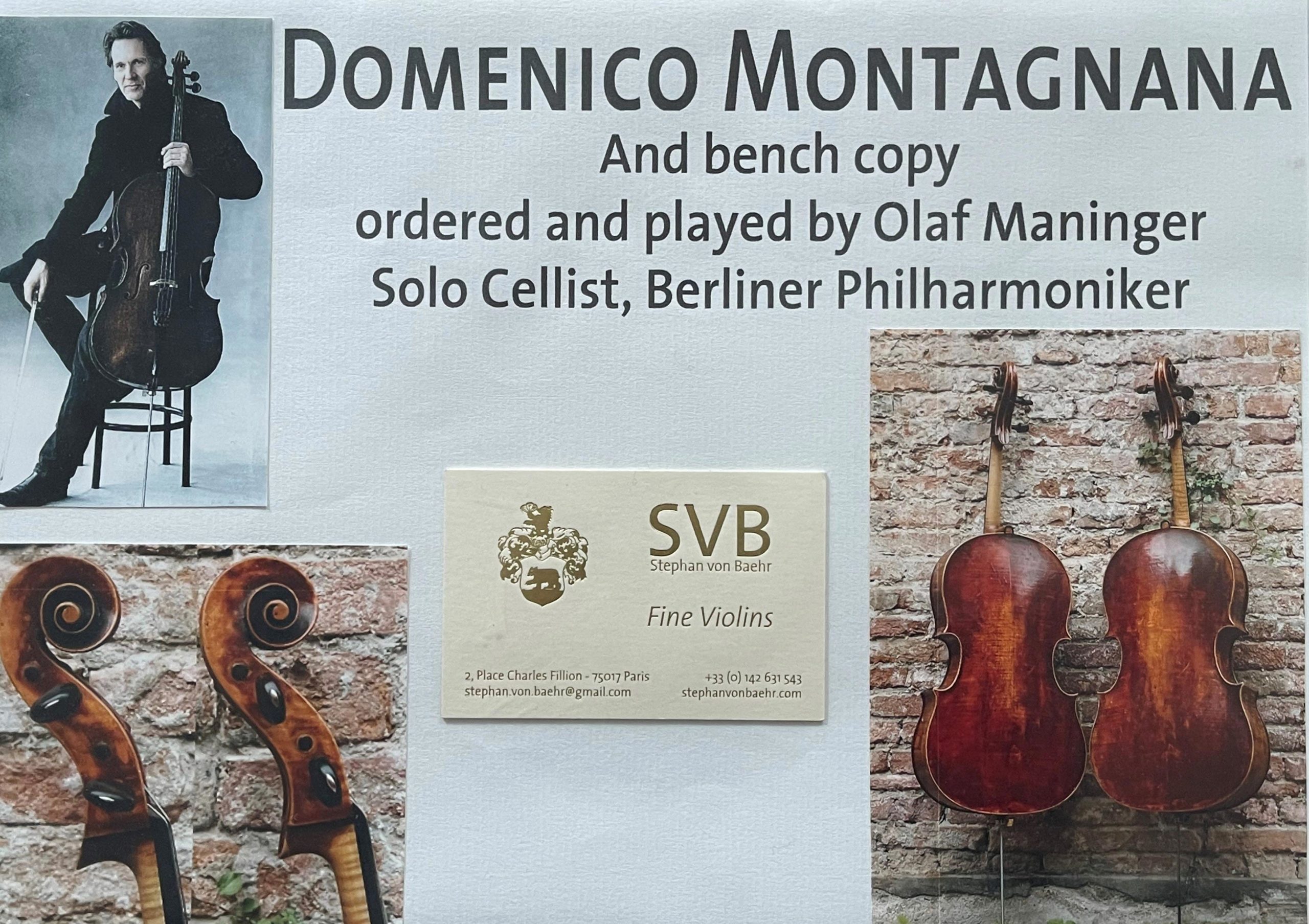
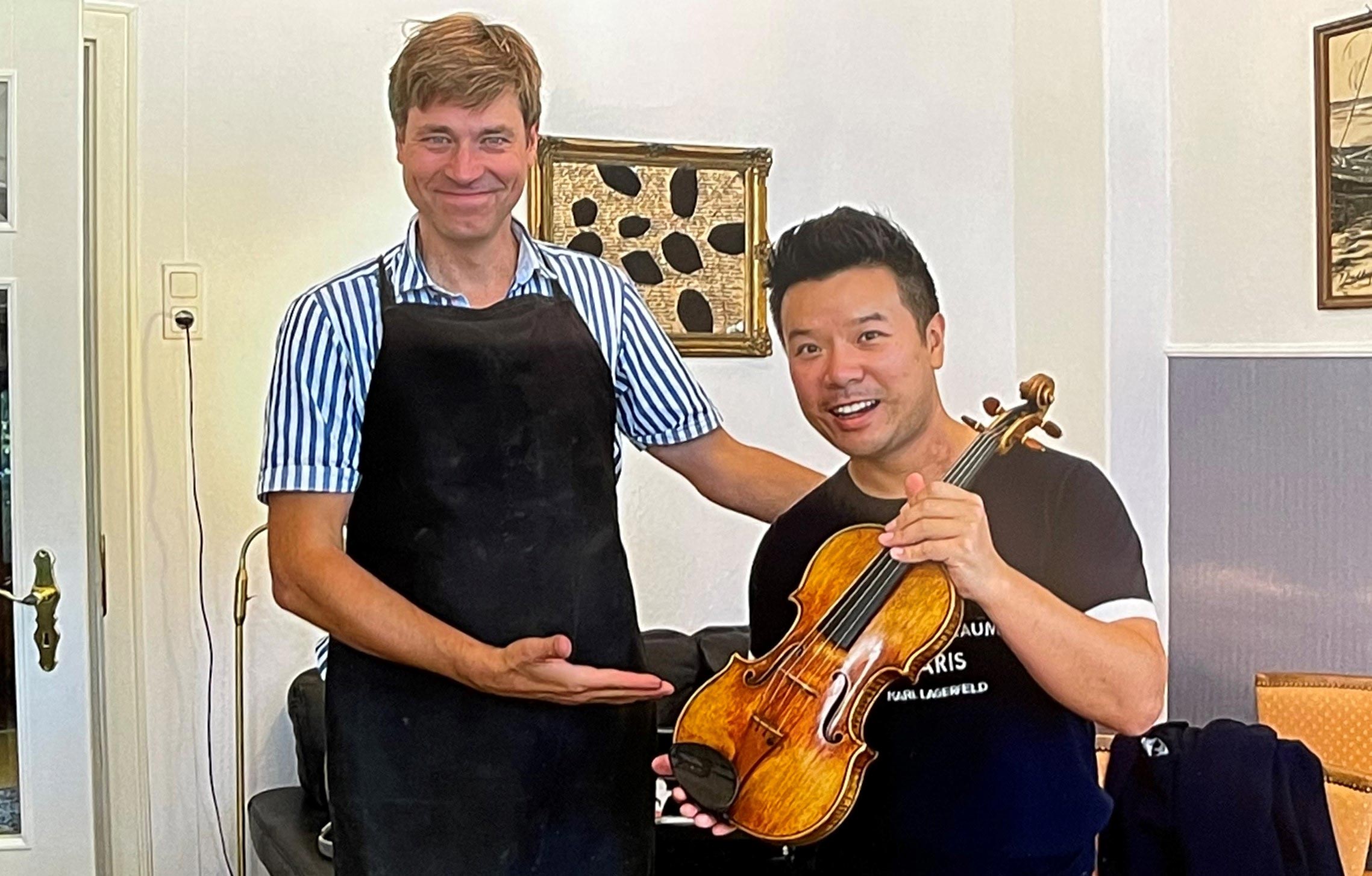
Les musiciens font donc particulièrement confiance au luthier. On retrouve ainsi un grand nombre de ses créations jouées par les violons, altos et violoncelles solos des orchestres philharmoniques de Berlin, de Vienne, de Séoul, du Metropolitan Opera de New York ou encore de l’Opéra de Paris. Comme le souligne Stephan, il s’agit d’un rêve de luthier de voir ses instruments dans les plus grands orchestres du monde. Une douzaine de premiers violons solos ont d’ailleurs acquis leur instrument auprès de Stephan alors qu’ils auraient pu se le faire prêter. En effet, ses instruments font l’objet de prêts par de grandes fondations allemandes et françaises, telles que la Deutsche Stiftung Musikleben ou la Société Générale.
Pour l’anecdote, le luthier fut particulièrement heureux d’entendre jouer – à l’occasion de concerts du Philharmonique de Vienne – pas moins de six altos de sa main. Son travail séduit aussi les grands solistes de nos jours – comme en témoigne l’exemple d’Isabelle Faust – et s’étend jusque dans les pays asiatiques où ses créations sont jouées par plusieurs célébrités, à l’image de la coréenne Dami Kim (médaille d’or au concours international de violon Joseph Joachim, Hanovre / Voir vidéo de Dami Kim jouant sur le violon de Stephan von Baehr, 26ème minute) ou du chinois Ning Feng (Grand Prix concours Paganini, Gênes).
Cette reconnaissance s’explique par une recherche constante du modèle idéal, reposant sur l’étude des grands maîtres et l’expérimentation. Cet examen dans les moindres détails des modèles anciens, en particulier de Guarneri et Stradivari, lui permet de s’en imprégner. Stephan von Baehr insiste sur la nécessité de l’observation visuelle et du contact avec les instruments anciens.
Son activité principale consiste à créer des instruments neufs, mais il réalise également des pièces d’instruments anciens, à l’image d’une volute ou d’une table d’un Stradivari. Ce travail sur les originaux lui permet d’en comprendre la construction et d’en percer les secrets… Il s’attache ainsi à reproduire les vernis des maîtres crémonais, ou encore leurs filets, en respectant les procédés de fabrication en pratique au début du XVIIIème siècle.
Le Faust a été réalisé suivant cette même logique de travail puisque son modèle s’inspire d’un original de 1714, le Dauphin, réalisé durant la période d’or du maître crémonais. Notons toutefois que l’œuvre est pensée comme une création indépendante – non une copie – soutenue par l’observation des originaux.
Estimant que les maîtres italiens ont mis au point les principes constructifs les plus aboutis, il en retient les modèles et les adapte en fonction des demandes des musiciens. Il conserve donc les meilleures inventions des plus grands luthiers de l’histoire – dont il réalise notamment des moulages – pour s’en servir comme repères pour ses créations, pensées pour le musicien, à l’image du Faust.
Comme l’explique Stephan von Baehr, l’idée est de travailler conjointement avec le musicien afin de concevoir un instrument parfaitement conforme à ses attentes. La fabrication du Faust en est un parfait exemple, puisqu’elle a donné lieu à de nombreux échanges entre les deux protagonistes qui ont fini par nouer une relation amicale. À plusieurs reprises, le violon a été ajusté pour correspondre davantage au répertoire de la musicienne et à la sonorité recherchée.
Ce lien entre le luthier et le musicien est central pour Stephan von Baehr et s’explique en partie par son enfance auprès de parents violonistes professionnels. En effet, il a pu observer leurs besoins et exigences durant toute son enfance et indique avoir été fasciné par la connexion entre le musicien et l’instrument. En travaillant conjointement avec Isabelle Faust, il a ainsi pu concevoir un instrument inspiré du Dauphin de Stradivari, avec la couleur sonore souhaitée par la virtuose et ce grâce à de multiples petits changements qui le singularisent.
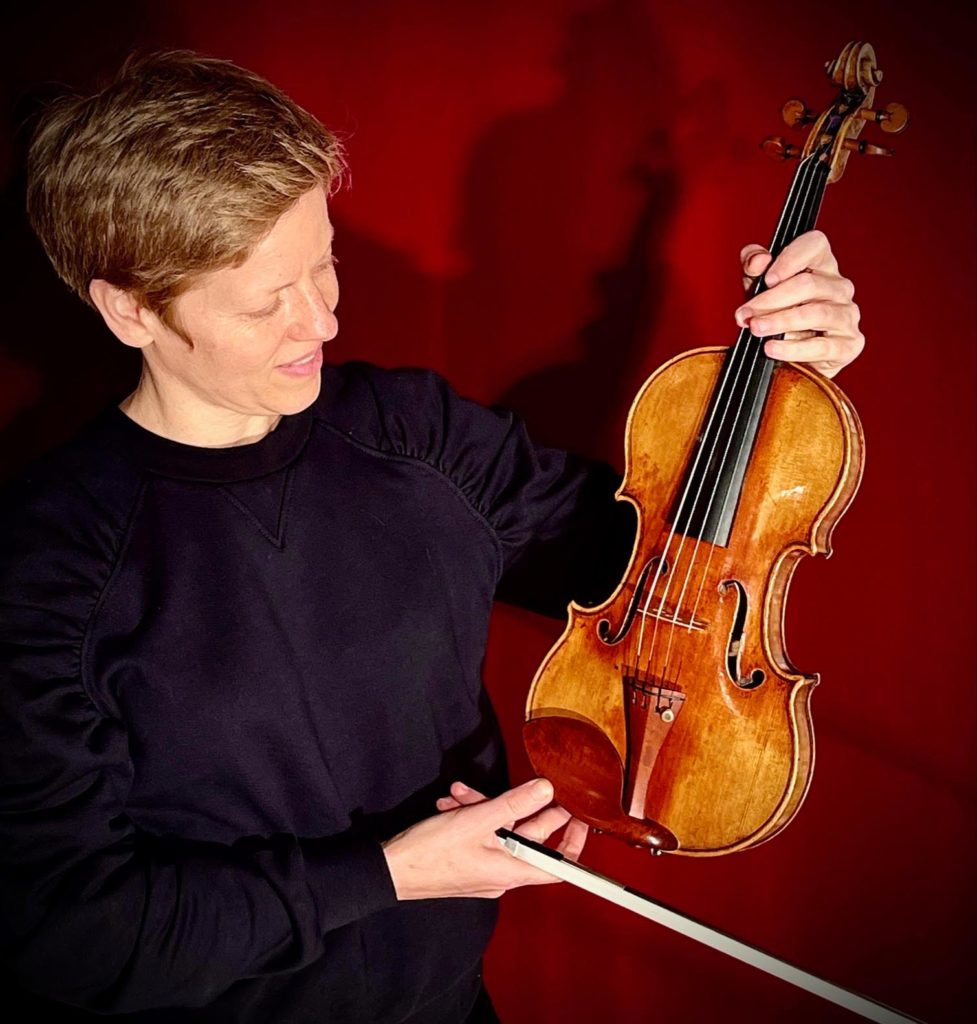
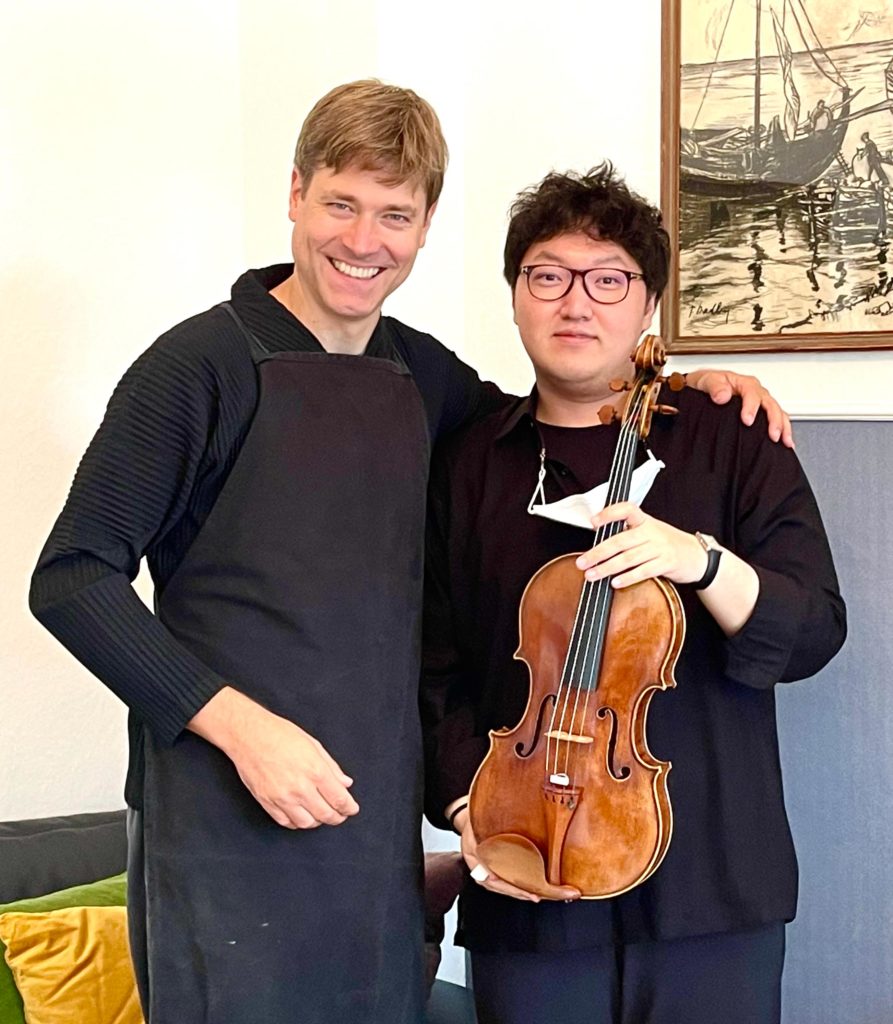
“ Le son qu’elle produit est passionné, nerveux, électrisant, mais il possède aussi une chaleur, une douceur désarmantes qui dévoilent les ressorts lyriques secrets de la musique… ”
New York Times
Isabelle Faust est réputée pour sa lecture sensible et approfondie des œuvres, donnant lieu à de captivantes interprétations mêlant passion et fragilité. La qualité de l’instrument avec lequel elle joue est donc primordiale pour exalter sa poésie musicale et lui permettre d’aller au cœur des œuvres. Par conséquent, l’enjeu pour Stephan von Baehr était de fabriquer un violon conforme au jeu de l’artiste et capable de sublimer la pureté et l’expressivité des interprétations d’Isabelle Faust.
Au dire de la principale intéressée, ce fut chose faite. À la lecture de cette note, on sent que la musicienne a profondément aimé son instrument et que celui-ci lui a permis de vivre d’intenses émotions, en particulier grâce à sa grande palette de couleurs sonores.
Isabelle Faust est née en Allemagne en 1972 et a très vite fait preuve d’un talent précoce. Elle prend des leçons auprès de Christoph Poppen et Dénes Zsigmondy et fait partie des lauréats les plus jeunes lors de prestigieux concours internationaux. Elle reçoit ainsi un prix à l’âge de 15 ans, au concours Leopold Mozart d’Augsbourg et remporte le concours Paganini de Gênes en 1993.
Rapidement, les plus grands orchestres du monde l’invitent à se produire sur scène, du Berliner Philharmoniker au NHK Symphony Orchestra Tokyo, en passant par le Boston Symphony Orchestra et le Chamber Orchestra of Europe. Elle travaille en relation étroite avec les plus importants chefs d’orchestre de l’époque et enregistre régulièrement avec eux. Elle joue notamment sous la direction de Claudio Abbado et enregistre en 2012 les concertos de Beethoven et Berg chez Harmonia Mundi.
Cet enregistrement fut récompensé par de nombreux prix, dont le Diapason d’Or, l’Echo Klassik, le Gramophone Award ou encore le Record Academy Award au Japon[1]. Sa connaissance approfondie des œuvres et de leurs contextes historiques l’amène à parcourir un vaste répertoire, d’Heinrich Biber (1644-1704) à Helmut Lachenmann (1935-). Elle apprécie aussi bien la musique de chambre que les compositions contemporaines et s’intéresse à toutes les configurations musicales[2]. Elle se produit fréquemment avec le pianiste Alexander Melnikov et est actuellement en résidence au Palais des Beaux-Arts de Bruxelles pour la saison 2020-2021.
[1] https://www.grandsinterpretes.com/artiste/isabelle-faust/
[2] https://prades-festival-casals.com/isabelle-faust-2/
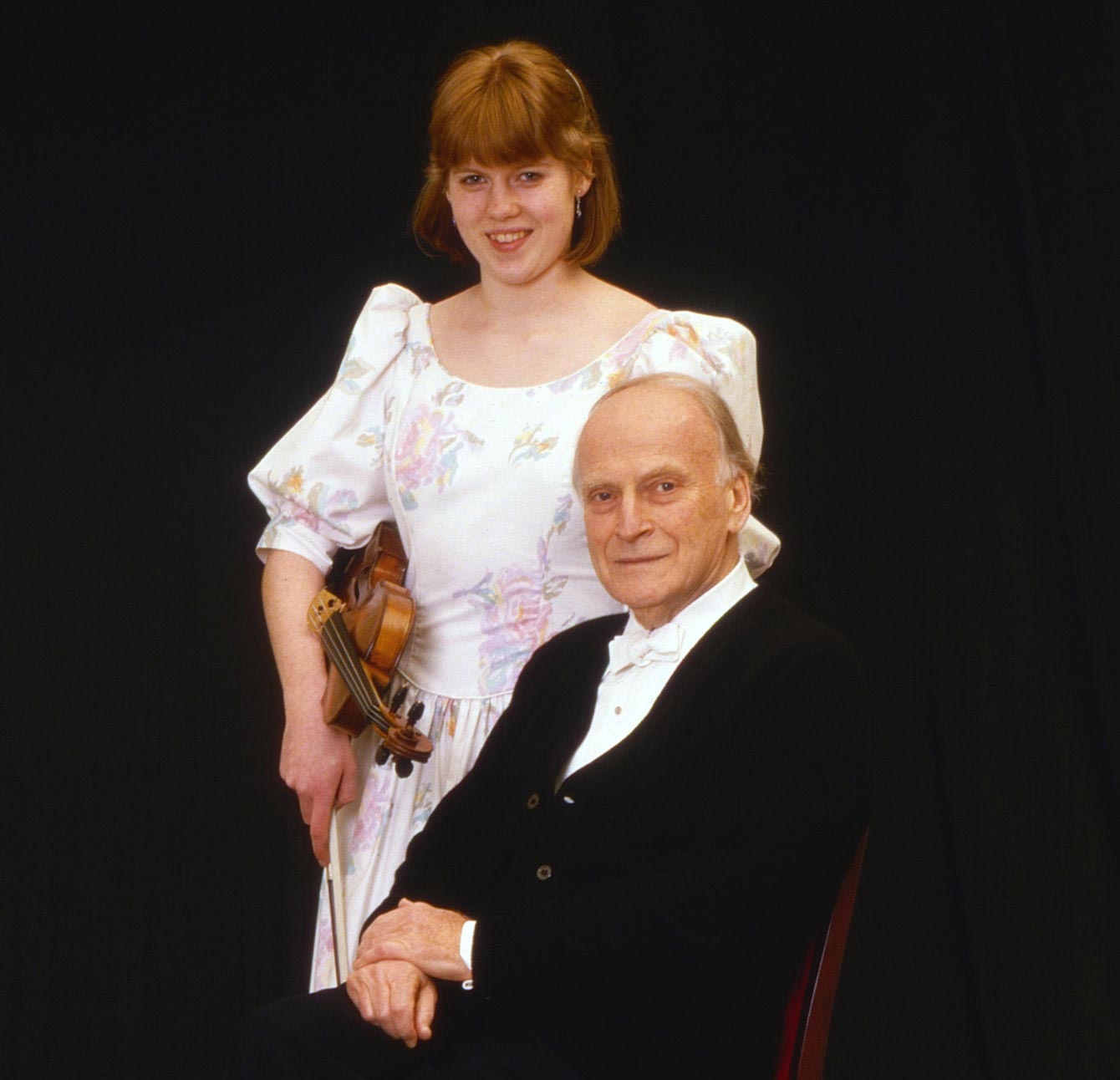
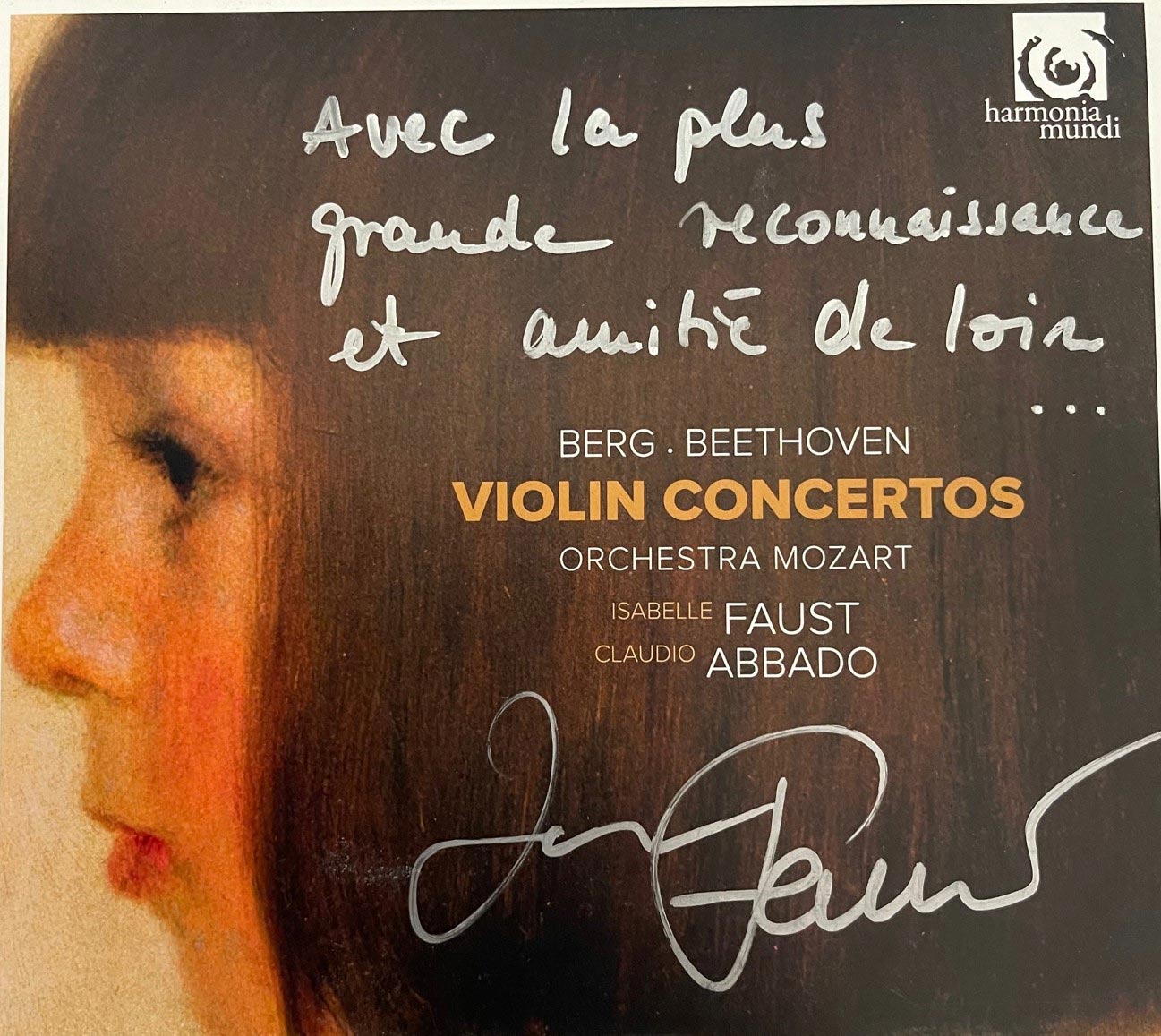
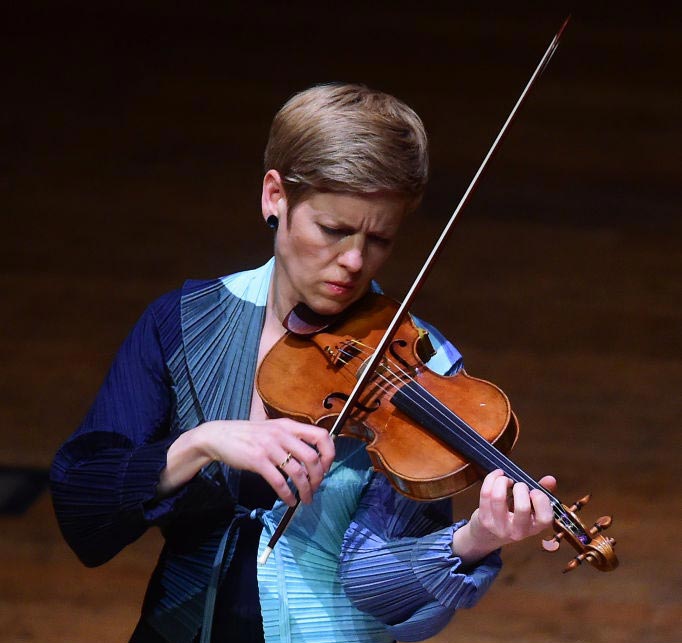
Isabelle Faust est l’une des musiciennes contemporaines les plus sollicitées et estimées au monde. Sa carrière déjà bien remplie et ses multiples enregistrements confirment le caractère exceptionnel de son talent.
Amoureuse de l’ancien comme du contemporain, elle ne pouvait qu’apprécier le savoir-faire de haute qualité de Stephan von Baehr. Leur collaboration a donné naissance à ce superbe violon, surnommé le Faust, qui marqua la carrière de la virtuose.
Le 2 décembre 2021, il sera vendu à Vichy Enchères à un futur propriétaire qui, à n’en pas douter, partagera cette même poésie musicale et grande sensibilité…
Auctions of string quartet instruments usually mainly include examples by great masters of the past – often dead for centuries – which may lead us to believe that the art of lutherie died with them. However, lutherie of the highest standard still exists today, and can be credited with producing wonderful instruments, sought after by the greatest virtuosos of our time. This is the case of the violin which is the subject of this article and will be sold on 2 December 2021: the Faust, a violin made by Stephan von Baehr that belonged to Isabelle Faust.
Stephan von Baehr is one of those people whose passion is infectious. Driven by a love of the violin and esteem for the old masters, his instruments combine traditional craftsmanship and feedback from musicians. As he explains, his passion undoubtedly came from his parents, who were both first solo violinists, and probably developed after the fall of the Berlin Wall. Having grown up in East Germany, a whole universe opened up to him in 1989, offering him the opportunity to discover the instruments of the great masters he dreamed about for so long… After an apprenticeship in Reinhard Bönsch’s workshop in Markneukirchen, where he also trained in sculpture with Jochen Heinzmann around 1990, he joined Andreas Kägi in Berlin and meticulously studied several Stradivari instruments.
From 1993, he was employed at Sabatier in Paris and perfected his skills in restoration and expertise of old instruments. Since then, Stephan von Baehr has not stopped travelling, dividing his life between Hamburg and Paris, as well as having a significant presence in English-speaking and Asian countries. Today, he is one of the most renowned and sought-after living violin makers in the world. His passion is truly infectious, as demonstrated by the fact that his daughter, Léonie von Baehr, also became a violin maker two years ago and has since joined him in his workshop. His succession therefore seems perfectly assured…
In his 30-year career, Stephan von Baehr has built a reputation that speaks for itself. After graduating as a Master Luthier in 1995, his work quickly became successful, in part thanks to the 1998 RNCM International Cello competition in Manchester, in which one of his instruments gained recognition from the jury then chaired by Charles Beare. This event was decisive as it encouraged Stephan von Baehr to establish his own workshop on rue de Rome in Paris, in order to make his own instruments. A year later, he won the gold and bronze medals at the international lutherie competition of the city of Paris, a competition created by Étienne Vatelot, a famous violin maker whose violin expertise consultancy firm works with Vichy Enchères.
Since then, Stephan has remained in close contact with Maison Vatelot and its successors Jean-Jacques Rampal and Jonathan Marolle. Therefore, Stephan von Baehr’s career has been marked by successes around the world, whether in Europe, Asia or the United States, where he won several awards for his quartets of instruments – the ultimate recognition for a violin maker. His first award was a silver medal in 2004 at the Portland International Violin Making Competition, as well as three special prizes for each of his quartet instruments (violin, viola and cello). This was followed in 2012 by a gold medal for the quartet he entered at the Cleveland International Violin Making Competition.
The quality of his instruments is also in evidence through their presence in the greatest orchestras. As a result, they are played by the most talented musicians of our time. This is particularly interesting since it would have been almost inconceivable twenty years ago for a solo violinist to play on a new instrument. There has been a change in mentality that can be explained, among other things, by the work of violin makers like Stephan von Baehr.
Rainer Honeck, concertmaster of the Vienna Philharmonic Orchestra, is a case in point, as he appeared in the Strad magazine edition of February 2013 with his 1709 Stradivari alongside its copy made by Stephan. The principal cellist of the Berliner Philharmoniker, Olaf Maninger, also did not hesitate to present his copy of his Domenico Montagnana cello to the press. Finally, Xiaoming Wang – leader of the Quatuor Stradivarius de Suisse and principal violin of the Zurich orchestra – currently plays on a copy of the Aurea Stradivarius of 1715, an instrument that has accompanied him for the last 17 years.




Therefore, musicians have great confidence in this violin maker. Many of his instruments can be found played by the violin, viola and cello soloists of the philharmonic orchestras of Berlin, Vienna and Seoul, as well as of the Metropolitan Opera in New York and the Paris Opera. As Stephan points out, it is a violin maker’s dream to see his instruments represented in the greatest orchestras of the world. In fact, a dozen of first solo violinists acquired their instrument from Stephan despite being able to have these instruments loaned to them instead. Indeed, his instruments are loaned by large German and French foundations, such as the Deutsche Stiftung Musikleben or that of Société Générale.
As an anecdote, the violin maker was particularly happy to hear – at concerts of the Vienna Philharmonic – no less than six violas by his hand. His work also appeals to great soloists these days – as illustrated by the violin of Isabelle Faust – and this appeal extends to Asian countries where his instruments are used by several high profile players, such as the Korean Dami Kim (gold medal at the Joseph Joachim international violin competition in Hanover / See video of Dami Kim playing on the violin by Stephan von Baehr, 26 minutes into the footage) or the Chinese Ning Feng (Grand Prix of the Paganini competition in Genoa).
This recognition can be explained by his constant search for the ideal model, based on the study of the great masters combined with experimentation. Therefore, an essential aspect of his work is to study historical examples, in particular by Guarneri and Stradivari, in order to become be very familiar with them and to be able to examine their smallest details. Stephan von Baehr emphasizes the importance of visual observation and exposure to old instruments.
His main activity is to create new instruments, but he also makes replacement parts for old instruments, such as a new volute or front for a Stradivari. This work on the originals allows him to understand their construction and discover their secrets… In doing so, he is able to reproduce the varnishes of the Cremonese masters, or their purfling, while staying true to the making processes in use at the beginning of the 18th century.
The Faust was produced following the same working methodology, since its model was inspired by an original Stradivari from 1714, the Dauphin, made during the golden period of the Cremonese master. Note, however, that the work is thought of as a creation in its own right – not a mere copy – fed by the observation of the original instrument.
He believes that the Italian masters developed the most successful construction principles, and he therefore uses their models and adapts them according to the musicians’ needs. He incorporates the best innovations of the greatest violin makers in history – making plaster casts of their instruments in the process – and uses them as benchmarks for his own creations, which are designed for the musician, such as in the case of the Faust.
As Stephan von Baehr explains, the idea is to work together with the musician in order to create an instrument that perfectly meets their expectations. The making of Faust is a perfect example of this, since it gave rise to numerous exchanges between the maker and the musician, who ended up forming a friendship in the process. On several occasions, the violin was adjusted to better match the musician’s repertoire and the desired tone.
This bond between maker and musician is central to Stephan von Baehr’s philosophy and can be explained in part by his childhood, since both his parents were professional violinists. Indeed, he was able to witness first hand their needs and requirements throughout his childhood, and he indicates that he was fascinated by the connection between the musician and the instrument. By working jointly with Isabelle Faust, he was able to create an instrument inspired by Stradivari’s Dauphin, while achieving the spectrum of sound desired by the virtuoso by making small, singular, alterations to the original model.


“ The sound it produces is passionate, nervous and electrifying, but it also possesses a disarming warmth, a sweetness which reveals the secret lyrical qualities of the music…”
New York Times
Isabelle Faust is renowned for her sensitive and in-depth reading of works, giving rise to captivating interpretations combining passion and fragility. The quality of the instrument with which she plays is therefore essential to exalt her musical poetry and allow her to reach the heart of the works. As a result, the challenge for Stephan von Baehr was to make a violin that took into account the artist’s playing style as well as being capable of channelling the purity and expressiveness of her performances.
According to the musician, this was achieved. Reading this note, we feel that the musician deeply loved her instrument and that it allowed her to experience intense emotions, in particular thanks to its large palette of sound colours.
Isabelle Faust was born in Germany in 1972 and showed precocious talent. She took lessons with Christoph Poppen and Dénes Zsigmondy and is one of the youngest winners of prestigious international competitions. Indeed, at the age of 15, she received a prize in the Leopold Mozart competition in Augsburg, and won the Paganini competition in Genoa in 1993.
Shortly afterwards, she was invited to perform with the greatest orchestras in the world, from the Berliner Philharmoniker to the NHK Symphony Orchestra Tokyo, via the Boston Symphony Orchestra and the Chamber Orchestra of Europe. She worked closely with the greatest conductors of the time and recorded regularly with them. In particular, she played under the direction of Claudio Abbado, recording with him in 2012 the concertos of Beethoven and Berg with Harmonia Mundi.
This recording won numerous prizes, including the Diapason d’Or, the Echo Klassik, the Gramophone Award and the Record Academy Award in Japan[1]. Her in-depth knowledge of the works and their historical context led her to explore a vast repertoire, from Heinrich Biber (1644-1704) to Helmut Lachenmann (1935-). She enjoys chamber music as much as contemporary works, and is interested in all musical forms (3). She performs frequently with pianist Alexander Melnikov, and is currently in residence at the Palais des Beaux-Arts in Brussels for the 2020-2021 season.
[1] https://www.grandsinterpretes.com/artiste/isabelle-faust/
[2] https://prades-festival-casals.com/isabelle-faust-2/



Isabelle Faust is one of the most sought-after and esteemed musicians in the world today. Her stellar career to date and numerous recordings confirm the exceptional nature of her talent.
A lover of the old and the new, she could not fail to appreciate the high quality of Stephan von Baehr’s craftsmanship. Their collaboration gave birth to this superb violin, known as the Faust, which left an indelible mark on the virtuoso’s career.
On 2 December 2021, this violin will be sold at Vichy Enchères to its future owner who, undoubtedly, will be able to share this same musical poetry and great sensitivity…